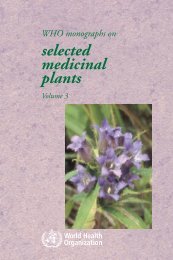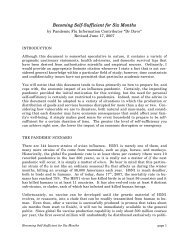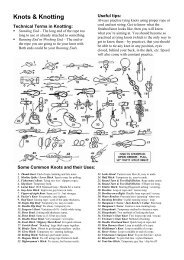Create successful ePaper yourself
Turn your PDF publications into a flip-book with our unique Google optimized e-Paper software.
WHITE SPORE PRINT<br />
name is not altogether fitting because the ring is often inconspicuous<br />
or even absent in all but very young specimens. Mellea, meaning<br />
honey-like, is descriptive of the color of the fungus, not the<br />
taste. The species is characterized by (i) white spores, (2) gills<br />
that taper downward on the stem, and (3)3 delicate, cottony ring<br />
connecting the cap and stem of young plants.<br />
Like other organisms that grow under many different conditions<br />
it varies a great deal, and even after one has known and<br />
gathered it for years he continually meets forms that differ just a<br />
little from the type (Figure 13 and Plate 2D).<br />
A. mellea is interesting not only because of its variability but<br />
because it has frequently been suspected of being a menace to<br />
orchard, forest, and shade trees, rotting the roots and thus killing<br />
the trees. Normally it lives on dead roots and other woody debris<br />
and spreads by means of black, string-like aggregations of mycelium<br />
(whence the name shoestring) that grow through the soil<br />
from one root to another. One of these strings may invade the root<br />
of a living tree by growing directly through the bark, and once<br />
inside it spreads out in the soft wood underneath, killing the tissues<br />
as it advances. At the same time it grows into and rots the wood<br />
of the root, reducing it to a white, stringy or spongy pulp. It also<br />
advances up into the trunk of the tree, causing a fairly common<br />
heart rot in both shade and forest trees. The decayed wood is<br />
usually luminescent, glowing in the dark with a pale yellow light —<br />
an eerie enough sight to come upon of a rainy night!<br />
The fruit bodies almost always come up in clumps, often in such<br />
numbers and so close together as literally to cover the earth. In<br />
a recently cutover woodland in central Minnesota the author<br />
counted five hundred fruit bodies in an area twelve feet square,<br />
amounting to at least a bushel in volume, and they were only<br />
slightly less numerous in other patches scattered over several acres.<br />
On our lawn in St. Paul hundreds of them have formed an almost<br />
solid carpet about three feet wide and thirty feet long, apparently<br />
nourished by the decayed root of an oak cut down many years ago.<br />
The most common variety is rather squat, with a pale brown<br />
37
















